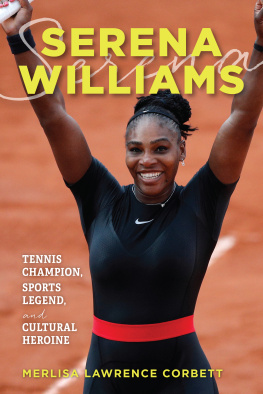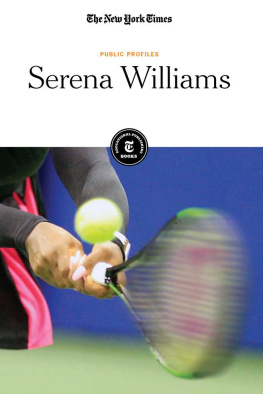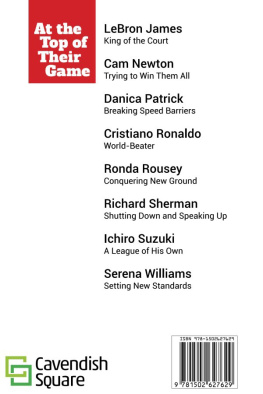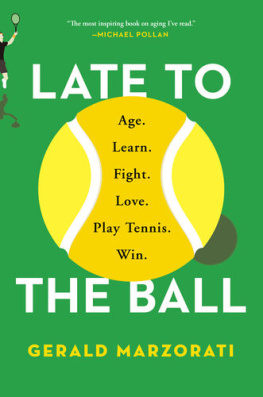The author and publisher have provided this e-book to you for your personal use only. You may not make this e-book publicly available in any way. Copyright infringement is against the law. If you believe the copy of this e-book you are reading infringes on the authors copyright, please notify the publisher at: us.macmillanusa.com/piracy.

FROM THE FLOOR OF CENTER COURT, Arthur Ashe Stadium rises up in every direction some 120 feetas tall as an eleven-story building. It includes seating for 23,771 fans in bleachers, grandstands, luxury boxes, and even five restaurants. This is the largest tennis stadium in the world. It may also be the most intimidating.
A row of TV cameras beams the action from the middle of New York City to homes all around the globe. Combine that with all the people seated above in the stands, cheering and shouting down after each point, and it can feel like everyone is watching. Some players compare it to playing inside a fishbowl.
The famed asphalt courts are home to some of the most intense competition in tennis. Its where every young player in the world wants to come and win the annual United States Open.
In September 1999, Serena Williams was one of those kids, just seventeen years old at the time.
By almost any equation, Serena wasnt supposed to be there. Not yet, at least. Not ever, perhaps.
Yet there she was, in the womens singles final, serving for match point and a chance to win her first major championship in straight sets over world-class competitor Martina Hingis.
It was a surprise to everyone but Serena and her family. Growing up, her father used to encourage Serena and her older sister Venus to dream. During breaks in practices, he would ask them which of the so-called major tournaments they wanted to winthe US Open, the French Open, the Australian Open, or Wimbledon, which is played outside London, England. Venus always said Wimbledon, the oldest of the events. It is known for its pristine grass courts, white uniforms, and royal family inspired sophistication.
Serena always shook her head at her sisters answer. I just said, the Open, she recalled.
She wanted the wild tournament, the loud tournament, the American tournament. She wanted the toughest onewith fast, hard-surface courts, played in the heat and humidity of August in New York. She wanted to be surrounded by the pressure that comes from all those fans crammed in around you.
Now here she was. She would still be in high school if tennis training hadnt forced her to be homeschooled, allowing her to graduate early. Her fashionable white-and-yellow tennis outfit and her hair pulled back and braided with white beads were signs of her youth. Her ferocious serves and ground game told a story of a kid who, as a player at least, was all grown up.
She was there to prove to herself that she was capable of being a champion. She was there to prove that she was capable of being better than her older sister. Venus, who was one year, three months, and nine days older, had burst onto the scene first and cast such a shadow that Serena was still referred to by many as Venuss little sister. Serena knew winning the US Open before Venus would go a long way toward changing that. She didnt want to be the little sister. She wanted them together to be known as the Williams sisters.
To do so, she needed to best Hingis, the number-one-ranked player in the world. Hingis was just nineteen, only a little older than Serena, yet she already owned five major championships. Hingis was classically trained and possessed incredible speed, skill, and shot-making ability. She hailed from Switzerland and was a child prodigy, playing in tournaments by age four. When, at the age of sixteen, Hingis won Wimbledon, she became the youngest singles major champion ever. To defeat her would be an incredible accomplishment.
More than anything, Serena was there to prove that a kid like her could do this.
Serena didnt grow up in a wealthy suburb. She didnt learn the game at a country club. She wasnt part of a youth development program in a tennis-mad community in the United States or Europe, like so many other elite players. The Williamses grew up in Compton, California, an impoverished neighborhood that sits just south of downtown Los Angeles.
They were taught the game by their parents, who learned it by teaching themselves. They were African Americans in a sport with so few people of color. Their hard-driving father, Richard, got them out on the court at age three because he believed he could create champions who could earn millions.
They never had the best equipment. They were always asking for donations and used to carry milk crates full of old balls out to practice. Eventually, when their supply got too big, they wheeled a beat-up grocery cart onto the court. Even as a toddler, Serena never had a junior-sized racket because it cost too much. She learned to play with an adult racket that was nearly as big as she was. She later credited it with teaching her to swing so hard. There was no other choice. Serena was forced to use every muscle she had to whip it around and smack the ball.
The Williamses practiced not on manicured lawns or glistening private courts but on the cracked concrete of public parks in Compton and the nearby neighborhood of Lynwood.
Serenas father would load the girls into a van, pull up each afternoon to an empty court, and shoo away whoever was hanging around at the timepeople dealing drugs, gambling on dice games, or just sleeping on a bench. Then the family would sweep the court clear of broken glass and debris to begin practice. All around, people would stop and stare. This was an unusual sight for Compton: a dad trying to teach his girls tennis. When they practiced, it wasnt uncommon for the sound of gunshots to ring out in the distance. Serenas dad would tell the girls to ignore it or pretend it was just a balloon popping.
At the 1999 US Open, Serena was asked if she ever got distracted. Many of her opponents did when airplanes flew over the courts as they approached nearby LaGuardia Airport. Serena never seemed to blink. It was as though she didnt hear a thing.
Didnt bother me, she said. Im from Compton. Im used to it. Theres just all kinds of other activities going on.
That is how Richard Williams did things. He tried to turn every negative into a positive. As balls wore out and bounced in unexpected directions, for example, he wouldnt replace them because that cost money. Instead, Richard told the girls that it prepared them for when they got older and competed against great players who could put spin on shots. Having old tennis balls was a good thing.
Maybe because of her fathers attitude, Serena never doubted her abilities, at least publicly. She always believed she would play at Arthur Ashe Stadium. Serena always believed she would win the US Open and other major championships.
When I am on my game, nobody can beat me, Serena said earlier in the tournament. I think its impossible for anyone to have a chance against me when Im playing my best.
Confident comments like that, from a teenager who hadnt yet won a major, bothered some people in tennis. It is a sport that values politeness. The game was first popular with the wealthy and elite of England back in the 1800s. It is a game of honor and sportsmanship, but it also was rooted in a day and age when it was mostly only white people of privilege who played.









